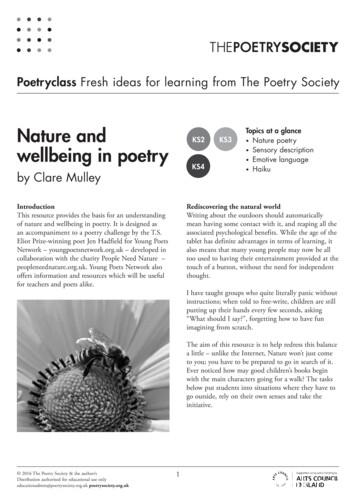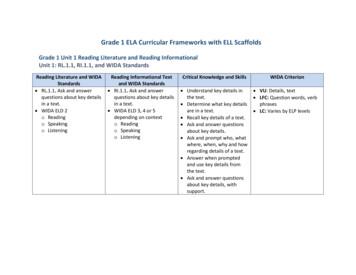A Short Guide To Poetry Part 1: Rhyming
A Short Guide to PoetryPart 1: RhymingTypes of RhymeEnd rhymeThis is the sort of rhyme we’re all used to: a rhyme that comes at the end of a line.Here are some examples (all of the examples are end-rhyme):Humpty Dumpty sat on a wallHumpty Dumpty had a great fallThis beat is my recitalI think it’s very vitalMary had a little lambIts fleece as white as snowAnd everywhere that Mary wentThe lamb was sure to go[You might have noticed that in the last example, only the second and fourth lines rhyme. The first and thirdlines do not. This is totally acceptable.]Internal rhymeInternal rhyme is rhyme that comes within a line of poetry. It is often combined with end-rhyme.Here’s an example from Eminem, who uses internal rhyme in all of his raps:His palms are sweaty, knees weak, arms are heavyThere's vomit on his sweater already, mom's spaghettiHere’s another example, from “The Jabberwocky” by Lewis Carrol:He left it dead, and with its headHe went galumphing back
Two-syllable rhymeYou can rhyme two syllables, as well as one (you can also rhyme three syllables, if you’d like to!). Normally,this works best if the stress comes on the first syllable rather than the second syllable.Here’s an example from “Bust a Move” by Young MC (it also includes internal rhyme):You’re on a mission, And you’re wishin’Someone could cure your lonely conditionIt can be very effective to combine two-syllable rhyme with one-syllable rhyme, as Rudyard Kipling does in hisclassic poem, “If”:If you can dream - and not make dreams your master;If you can think - and not make thoughts your aim;If you can meet with Triumph and DisasterAnd treat those two impostors just the same;[There is also an example of two-syllable rhyme on the previous page. Can you find it?]Partial RhymePartial rhyme makes some people really uncomfortable, but others love it. It’s what you get when you rhymetwo words that share some sounds in common, but don’t rhyme perfectly. For example, when Eminem rhymes“sweaty” with “heavy”, that’s partial rhyme.Here’s another example, from “Strange Meeting” by Wilfred Owen:I am the enemy you killed, my friend.I knew you in this dark; for so you frownedYesterday through me as you jabbed and killed.I parried; but my hands were loath and cold.
Part 2: Poetic DevicesMessing around with the line: end-stopping and enjambmentEnd-stopping: sticking to the linesEnd-stopping means writing one thought per line (which, in most cases, means one sentence per line).Example:Shall I compare thee to a summer’s day?Thou art more lovely and more temperate.-William Shakespeare, “Sonnet 18”Enjambment: crossing the lineAn enjambment occurs when the line ends before your thought does, so it carries on into the next line. Youpronounce it like this: “En - jamb - ment”Examples:If you could hear, at every jolt, the bloodcome gargling forth from froth-corrupted lungs-Wilfred Owen, “Dulce et Decorum Est”And death is better, as the millions know,Than dandruff, night-starvation, or BO.-WH Auden, “Letter to Lord Byron”For your purposes, the most important thing to remember about this is that you don’t need to write your poemsso that every idea begins at the start of a line, and ends at the end of it.Devices for description: Metaphor and SimileMetaphor and simile are very similar. The distinction between the two is that in metaphor you describesomething as if it is something else, while in a simile you just say that something is like something else.An example of metaphorFogBY CARL SANDBURGTHE fog comeson little cat feet.It sits lookingover harbor and cityon silent haunchesand then moves on.
Two examples of simileThere are several lovely similes in this poem (in order to understand it, you should know that you can use apiece of flint to start a fire):FlintCHRISTINA ROSETTIAn emerald is as green as grass,A ruby red as blood;A sapphire shines as blue as heaven;A flint lies in the mud.A diamond is a brilliant stone,To catch th
Part 1: Rhyming Types of Rhyme End rhyme This is the sort of rhyme we’re all used to: a rhyme that comes at the end of a line. Here are some examples (all of the examples are end-rhyme): Humpty Dumpty sat on a wall Humpty Dumpty had a great fall This beat is my recital I think it’s very
Laila Ragab Marlena Rasmussen Prathamesh Sabarinath Lia Schwalje Molly Van Wyk POETRY 3 STORIES 27 BURSTS 31 OF CREATIVITY Inside this issue: GRANT SCHOOL LITERARY MAGAZINE . POETRY Page 3 By: Laila Ragab. POETRY Page 4 . POETRY Page 5 . POETRY Page 6 . POETRY Page 7 . Page 8 . POETRY Page 9 . POETRY Page 10 . POETRY Page 11 . POETRY Page 12 .
Poetry Texts Structure and features of poetry texts PURPOSE Poetry captures the essence of an object, feeling or thought. Poetry for children should reflect the emotions of childhood, making students feel sensory experiences to an intensified degree and satisfying their natural response to rhythm. FORMS OF POETRY Lyric poetry
affirmed that poetry should be shared every day—meshing with every area of the curriculum. To spark a love of poetry, to bring poetry into children’s lives in a meaningful, unforced way is one of the best gifts we can give. Reading, writing, collecting, and sharing poetry is my passion. The power of poetry forever mystifies me, for so much .
2.6.1 The Characteristics of English Poetry 19 2.6.2 The Importance of Poetry in the Classroom 21 2.6.3 Considerations and Principles of choosing an Educational Poetry 26 2.6.4 Strategies for Teaching Poetry in the Classroom 27 2.7 The Impact of Using Poetry on Devel
Poetryclass Fresh ideas for learning from The Poetry Society 1 Nature and wellbeing in poetry by Clare Mulley Introduction This resource provides the basis for an understanding of nature and wellbeing in poetry. It is designed as an accompaniment to a poetry challenge by the T
ESSENTIALS IN LITERATURE LEVEL 9: SAMPLE POETRY POETRY: LECTURE Day 1 - Elements of Poetry, Poetry Structure Day 2 - Sound Devices, Other Elements of Poetry Day 3 - Figurative Language DREAMS Day 1 - Meet the Author, Making Life's Connections Day 2 - Access the Backdrop, Analyzing Figurative Language: Metaphor, Elements of Poetry: Mood and Tone, Analyzing Figurative Language:
Read grade-level prose, poetry and informational text in L1 and/or single words of leveled prose and poetry in English. Read grade-level prose, poetry and informational text in L1 and/or phrases of leveled prose and poetry in English. Read short sentences of leveled prose, poetry and infor
Confessional poetry From Wikipedia, the free encyclopedia Confessional poetry or 'Confessionalism' is a style of poetry that emerged in the United States during the 1950s. It has been described as poetry "of the personal," focusing on extreme























